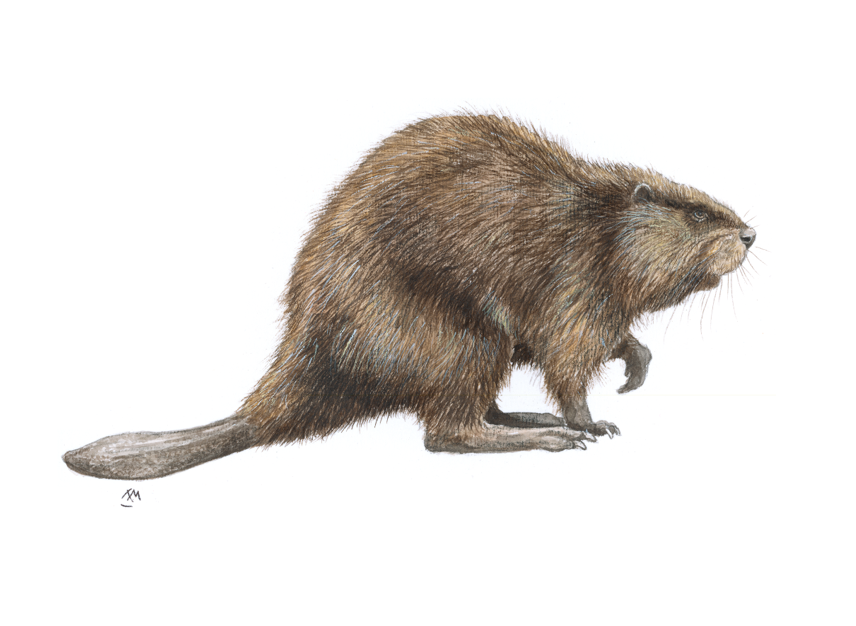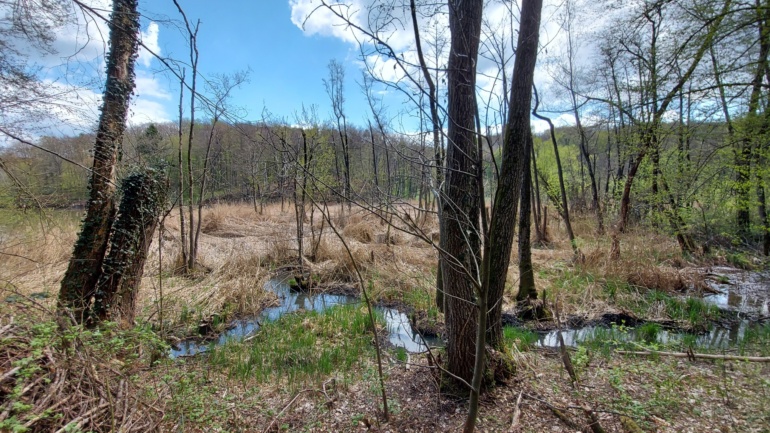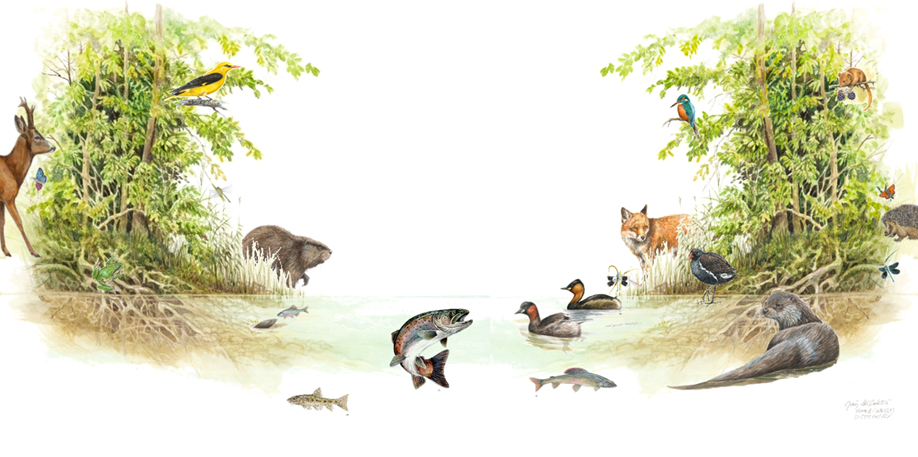ID Card
Eurasian beaver is the second largest rodent in the world. Besides its chisel like teeth – the front incisors, with which the beaver is effectively chewing tree bark and wood, its other main morphological characteristic is flattened tail covered with scales. Its chubby body is covered in dense, usually brown fur. Despite its short ears, its hearing is extremely good; its sight is relatively poor, but its smell is well developed and used also for communication. It has great swimming and diving capabilities. It walks on land on all four, sometimes it also moves short distances on its hind feet, meanwhile carrying in its front paws sticks or mud for construction.
The beaver is exclusively herbivorous and is looking for food within a 20 m range of the water edge. It is mainly feeding off tree bark, leaves and buds of various wood species (willow, poplar, alder …) as well as with herbs and aquatic plants. It can also fell trees as wide as 1 m in diameter, however it usually prefers smaller trees as the tiny twigs and leaves are easily reachable. During the periods of aquatic vegetation scarcity, it can also forage for food within the fields, meadows and orchards.
Body length without tail: 80 to 100 cm
Body mass: 23 to 35 kg
Tail: 30 to 34 cm length, up to 16 cm in width
Webbed feet for swimming are only present on hind legs.
Fur thickness: 12 000 – 23 000 hairs/cm2
Dental formula:
Upper row of teeth 1013
Bottom row of teeth 1013
Number of fingers:
Front paw has 5 fingers
Hind foot has 5 fingers (the claw on the 2nd finger is double and used for combing)
Scientific Classification
Class: Mammalia
Order: Rodentia
Family: Castoridae
Genus and species: Eurasian beaver (Castor fiber)

Ecosystem Engineer
Beaver is the largest European rodent and a key species of wetland habitats. Its life is inseparably linked with freshwater. With its engineered structures involving felled trees, beaver huts and dams, it can majorly re-construct and enrich aquatic ecosystems and with them ensure favourable conditions for various number of organisms. Named an ecosystem engineer, it creates and reconstructs wetlands, side watercourse channels and increases flow variability. By doing so, it mitigates the effects of climate change (droughts, floods), reduces amount of greenhouse gases and contributes to cleaner surface and underground waters.
Beaver, therefore, offers us several engineering services. Without beavers, we would have to hire civil engineers and water managers, paying them quite a lot of money!
Beaver activity in landscape provides favourable living conditions for various organisms and increase biodiversity of aquatic and semiaquatic ecosystems. Especially important is beaver created landscape high in biodiversity, as consequently, richer ecosystems are more resistant to climate change and negative influences from the surroundings (e.g., pollution). This is one of the main reasons why beaver is a key species of freshwater systems.
Fast flowing stream or river spills into a pond above a beaver dam, increasing biodiversity. Beavers create suitable environment for species that favour slower water flow. For example, certain species of amphibians, birds, insects, fish and aquatic plants. Deepened water behind a river dam becomes an important shelter for fish (and other aquatic inhabitants) during droughts and winters. Beaver activity (such as digging side channels and redirecting water-flow) increases biodiversity of animal and plant species in the area. Fallen tree logs can also become food source for deer, and abandoned beaver dams and huts can be used as a shelter by various animals.
Beaver feels safest in waters which are deep enough for complete submerging (at least to 80 cm depth) and therefore also hiding from predators. Beaver dams cause a slowdown of water flow and deepen the water depth. Sometimes, beavers also dig side watercourse channels, which enable easier access to food resources and building material. Beaver feeds itself exclusively on plant material.
It is true that behind the beaver dam, occasional flooding of surrounding landscape can occur, and can consequently cause anger among landowners and farmers. However, by raising water level and digging side channels beaver also creates and maintains wetlands, which are of paramount importance!
Wetlands are one of the most important and at the same time, most endangered ecosystems in the world. Since 1970, we lost already 35% of them and 90% since 1700. As wetlands disappear, we are also losing several ecosystems services, which play a key part in creating benefits for people and nature alike. The roles wetlands play are the following:
- retaining water, which is especially important now, when draughts are longer lasting and the water from the meadows and fields drains faster;
- wetlands protect us from floods. When the water from the river bed spills onto the wetlands, wet meadows and forests, the flooding effect in the valley lessens. Wetlands retain larger amount of water and enable slower and even run-off, consequently lessening the flood events;
- Wetlands contribute to cleaner surface and groundwater, they act as a natural filter, filtering water. Wetland vegetation and microorganisms, with the help of numerous biological processes, incorporate and transform damaging substances released into environment, such as pesticides, fertilisers and heavy metals;
- wetlands act as a water reserve from which the groundwater can refill itself;
- wetlands contribute to the reduction of greenhouse gasses; they act as a sink of carbon, nitrogen and carbon dioxide (these are favourable conditions for the wetland vegetation to grow in). Wetlands are, in biological terms, one of the ecosystems with the highest production on the Earth in comparison with the tropical rainforests and coral reefs!
- Wetlands are of key importance for the biodiversity: 40% of animal and plant species on our planet live or reproduce in wetlands.!
But now, it is our turn – will we let the beaver to do its job and create more wetlands?
As beaver went almost completely extinct in Europe, we lost touch with the engineering capabilities of this species, therefore, when problems arise, we are often under the impression that the beaver »steals« our agricultural land from us. Humans have for centuries, held back our watercourses in narrow, rigid and straightened paths, so that we kept as much space to ourselves as possible. Even today, when the law (Water Act, article 14) clearly states that we need to leave a 5 m wide, unmanaged belt of vegetation along the banks of narrower streams, brooks and a 15-40 m belt along river banks, it is completely different in practice. People stretch their agricultural and grazing fields right up to the edge of the bank.
With this action we did not do ourselves any favour. We will only increase our flood defences, if we will let our rivers and streams have enough space! Natural widening of the stream and river beds with side channels, sediments, meanders and bank vegetation are all favourable for self-sufficient cleaning capabilities of surface as well as groundwater.
Beaver, therefore, offers us several engineering services and uses completely natural material, without expensive, damaging and not always successful artificial regulations with the emphasis on concrete.
One of the goals of the European Water Framework Directive and the Slovenian Water Act is to reach high quality state of our waters. The directions of the European Green Deal, which is part of the European Biodiversity Strategy for 2030, is to return extensive 25.000 km of European rivers back to their natural state. Beaver can help us to reach this goal – that is, if we will let it get on with its work.
Lost and Re-discovered Species
The history of the Eurasian beaver (Castor fiber) is an example of a thoughtless act on behalf of humans and their overexploitation of various species in our natural world. Humans have ruthlessly hunted beaver because of its fur, meat and castoreum. At the beginning of the 20th century, the once widespread beaver, was on the verge of extinction.
The rivers and its banks gave way to the needs of agriculture and industry, they became canals without the bank vegetation and less hospitable for any kind of wildlife. With the disappearance of nature, the beaver also slowly moved out of conscience of men. It became an endangered and forgotten species.
In the last decades, we have seen the return of the beaver. The renewed beaver presence and the spread of meagre remnants of once robust populations once again brought the species along various European rivers across Europe and Asia. The populations recuperated and are again spreading across the continent without our aid. With its construction capabilities, the beaver can also re-engineer even the poorest and technologically changed aquatic environment, which it can adapt to its own ecological needs. It shows us the way to a natural renewal of aquatic ecosystems.




